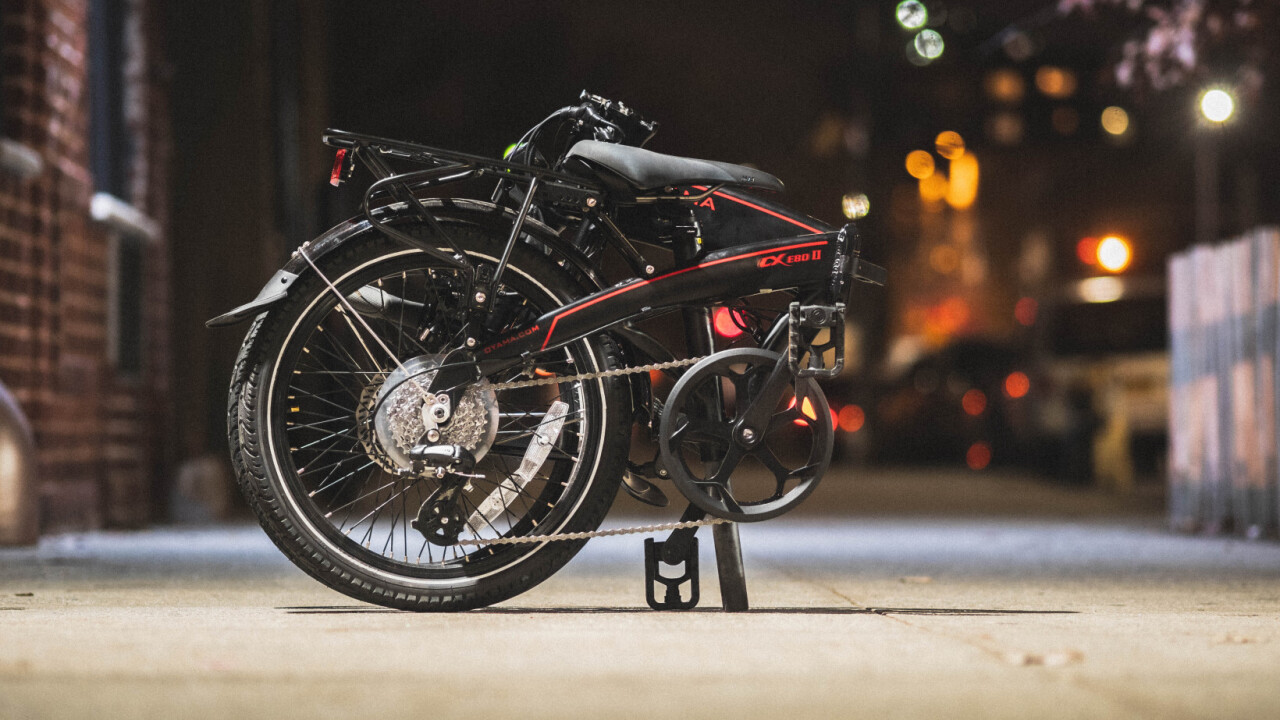
- Product
- CX E8D Series II
- Price
- $$1,999
After testing a few e-bikes this year, it’s quickly become apparent that they are the fastest way to get around a crowded city like New York, especially if you want the optional workout. But there are a few important caveats.
For one, e-bikes are typically big and heavy; many city dwellers already forgo regular bikes because they take up too much space in a small apartment or they don’t want to walk them up a flight of stairs. For another, you’ll be even more paranoid about locking them up. You’ll need at least two heavy-duty locks to protect your pricey purchase.
That’s where a folding bike like the $1,999 Oyama CX E8D Series II comes in.
Oyama is a Taiwanese company that’s been making folding bikes for decades and entered the US market with e-bikes more recently. At 42 pounds, the E8D lighter than most full-size e-bikes, and can fold down into the size of a large suitcase. Its compact size means you can often bring it indoors to meetings and restaurants, instead of leaving it exposed to thieves and weather. And unlike many folding bikes at its price point that compromise on ride experience and functionality, the E8D’s hardware makes it a pleasure to ride.

The E8D’s rear hub 350W motor may not sound like much when there are plenty of full-size bikes hitting the 750W US federal limit, but it’s actually a bit higher than the 250W motors you often see on folding models.
That said, having recently tested the Rad Power Bikes RadRunner and Juiced Bikes CrossCurrent X – both with 750W motors – I expected a big downgrade in performance. But in practice, I hardly noticed the difference in stop and go city traffic. The bike has eight levels of power and assist and felt positively zippy in its maximum power mode.
Mind you, I’m a 270lb rider, so power shouldn’t be a concern for most users. It also speaks to the stability of the frame, that I didn’t notice any flexing or otherwise feel like the bike was compromised by its heavy load.
The relatively small, 20 x 2 tires likely help here. Smaller tires generally mean less inertia, equating to slightly faster acceleration at the expense of less stability. More important is the bike’s 42lb weight. By comparison, the RadRunner and CCX are 65 pounds.
Like the CCX, the E8D has another trick up its sleeve: a torque sensor. Most e-bikes use a cadence sensor that provides a fixed boost depending on your assist level; it’s especially hard to find anything else on a folding bike. A torque sensor, on the other hand, adjusts power delivery depending on how hard you’re pedaling. It knows that you need more help going uphill than downhill, for instance, and both feels nicer and saves battery.

Moreover, the E8D’s torque sensor might actually be the smoothest power delivery of any e-bike I’ve tried to date, reacting instantly to my pedaling without any semblance of the jerkiness I sometimes experience on other bikes. Combine that with whisper-quiet operation, and you can hardly tell there’s a motor at work. Well, other than the fact you’re able to speed up hills like nobody’s business. It’s an immensely satisfying ride.
Speaking of speed, the E8D is limited to 20mph by default, which is good enough for most people. You can, however, set a different maximum speed in the display to meet local ordinances. New York is set to establish a 25mph speed limit for e-bikes, so that’s what I set it to on the E8D.
In practice, that’s about as fast as you’ll be able to go anyway, as I found the gearing to not be much help beyond 24 miles per hour. Also keep in mind the E8D has no throttle, if that’s important to you. You’ll be doing at least some pedaling all the way.
I was pleasantly surprised by how smooth the ride felt on rough city roads despite a lack of suspension. Oyama’s site says the bikes comes with Schwalbe Big Apple tires, but mine came with chunky 20 x 2.125 Kenda tires. Schwalbe is a more reputable brand, but the Kendas do a good job of absorbing bumps in the road.
The compact tires and narrow handlebars also make for superior maneuverability in city traffic, making it easier to squeeze between that cabbie yelling at a pedestrian.

The E8D also has hydraulic disc brakes, relatively rare on folding bikes, allowing it to brake like a champ. And the sturdy rear rack meant I didn’t worry about loading the bike with panniers full of groceries.
Less thoughtful is the choice of seat: I found the stock saddle to be awful, and I promptly replaced it with a Selle Royale Scientia. And while the folding pedals are a nice touch for compactness, they flexed a bit too much for my liking (of course, that’s contingent on your weight).
Despite those caveats, the E8D feels like a great bike before we even get to the folding capabilities. It takes less than 30 seconds to fold, and at its most compact, the E8D measures roughly 33 x 25 x 17 inches. It’s not the smallest or most elegant folding 20-inch bike I’ve seen; the GoCycle GX I recently tested folds a bit thinner and much more cleanly, but it’s small enough to tuck away in a closet or under a desk.
There are some clever touches here too. The folding mechanism uses a double latch for added security, and the seat post doubles as a stand to keep the bike upright once set to its lowest position. I was also told it comes with a velcro strap to hold the two sides together while wheeling the bike around in its folded position. My test unit did not, so I just used a bungee instead.

There are several subtle benefits to a folding bike I didn’t realize until I started testing them. When I had a meeting, I could generally bring the bike inside the venue. If I’m visiting a friend, the bike’s small enough to bring inside without being obnoxious.
While have to pay a fee to bring a non-folding bike on New York’s state’s Metro-North railroad, and are confined to off-peak hours and specific areas. Folding bikes are free and can go basically anywhere you want.
If a restaurant is large or empty enough, they might let you bring the bike inside, saving you the hassle and paranoia of locking up. Even locking up is easier: if you have a chain or folding lock, you can fold the bike and loop the lock through both wheels and the frame in one go – perfect for brief stops.
Lastly, if your battery runs out and/or you don’t feel like riding the rest of the way home, the E8D will fit in the trunk of most cars. At one point I had some knee pain and decided to drive home using a local carshare service; I managed to squeeze the E8D into the tiny cargo area of a Smart ForTwo.

I do have some caveats though. To sum them up:
- I’ve been spoiled by the 40-60 miles I can achieve with the 1000 watt-hour battery on the CCX. By comparison, the removable 362 Wh battery on the E8D – hidden within the frame and accessible when folded – gets me about 15-20 miles. Your mileage may vary depending on our weight, and keep in mind the E8D is relatively light so it’s easier to ride back home unpowered once the battery does run out.
- Oyama needs some serious work on its website. I couldn’t find folded dimensions or range information. You know, two pretty important things for a folding e-bike.
- I can’t find anywhere to buy official extra parts online. They are available neither on Oyama’s site or with the few dealers online, and local dealers are far apart. There are aftermarket batteries you can buy that should work, but I wish Oyama made it easier to purchase from official means.
- There’s no brake light, just a reflector, you’ll need to supply an aftermarket one.
- The headlight could be brighter for night-time riding. Mine came with a glitch that meant it always blinked unless I turned it off, although I was told this isn’t an issue with typical units.
- It only comes in one colorway: black with red accents.
- There are no official front basket options, as seen on some competing models from Rad Power Bikes, Blix, and Tern. Aftermarket ones are almost always less sturdy.

Despite a few caveats, the E8D is an impressively versatile package. It strikes a goldilocks balance of ride quality, weight, power, functionality, and price that’s relatively rare in full-sized e-bikes, let alone folding ones. If you’re looking for a supremely practical city bike that feels great to ride, it’s hard to think of a better deal than the CX E8D Series II.
The Oyama CX E8D Series II is available from Oyama’s website or a dealer for $1,999.
Get the TNW newsletter
Get the most important tech news in your inbox each week.



